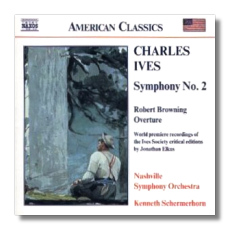
The Internet's Premier Classical Music Source
Related Links
- Ives Reviews
- Latest Reviews
- More Reviews
-
By Composer
-
Collections
DVD & Blu-ray
Books
Concert Reviews
Articles/Interviews
Software
Audio
Search Amazon
Recommended Links
Site News
 CD Review
CD Review
Charles Ives

New Critical Editions
- Symphony #2
- Robert Browning Overture
Nashville Symphony Orchestra/Kenneth Schermerhorn
Naxos 8.559076 DDD 66:30
There are many surprises awaiting the Ives fan who buys this CD. Schermerhorn is the first conductor to record Jonathan Elkus's new critical editions of these works; Elkus recently prepared these editions for the Ives Society. Like many of us, Elkus became familiar with the Second Symphony through Leonard Bernstein's old Columbia LP, which remains available on CD, and which still is in a class of its own. However, it is not widely known that Bernstein made interpretive and editorial decisions in the 1950s that are difficult to justify today. Some he could not help making, given the hurried manner in which the orchestral score was made ready for performance in 1951. Missing tempo markings may have led Bernstein to perform contrasting sections more slowly than Ives wished. (Take, for an example, "Where O Where are the Pea-green Freshmen?" in the second movement.) However, Bernstein actually omits material here and there; the largest cuts seem to be in the second and fifth movements. Sometimes only a bar or two is missing, but what a difference this makes! Ives' famously laconic response to hearing Bernstein's performance of this work on the radio might have been a gesture of dissatisfaction, not of modesty, as is sometimes claimed. The Robert Browning Overture was published in 1959, also with "myriad errors," according to Elkus.
For his new editions, Elkus (a faculty member at University of California at Davis) has relied, at least in part, on pencil holographs that were unavailable in the 1950s. Only the most casual of listeners will not hear the difference. It is certainly worth mentioning that conductors followed Bernstein's example, and that their recordings are much closer to Bernstein's than to Schermerhorn's.
This recording makes the music sound more naïve than I've ever known it to be. Part of the effect can be attributed to the editions, and specifically to the restored music, which creates a sensation of asymmetry. The performance itself also contributes to the effect. The Nashville Symphony Orchestra plays well, but certainly not with the polish and tonal splendor of the New York or the Los Angeles Philharmonics, two world-class ensembles who have recorded the Symphony #2. If the music sounds naïve or awkward, though, one suspects that Ives would not have been displeased. Schermerhorn and the musicians play the music with simplicity; there is no emotional manipulation of the listener. If you want a Tchaikovskian Ives, Bernstein remains viable, and he really needs to be heard anyway, given his importance in the Ives revival. However, if you want a truly "new look" at these works, this Naxos disc is a must-hear. Good recording, too.
Copyright © 2001, Raymond Tuttle


















